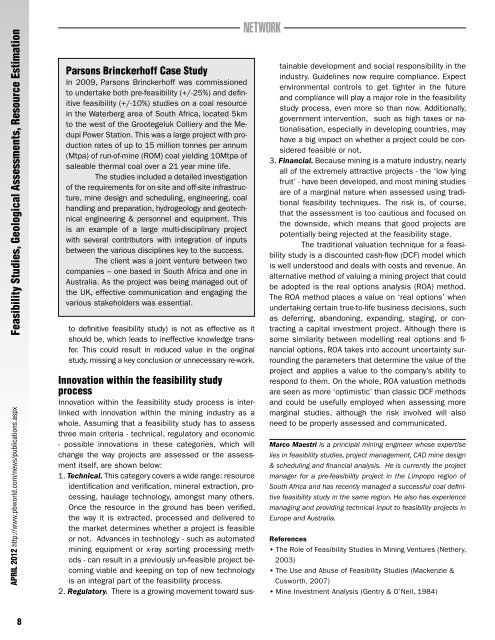Mining & Mined Caverns - Parsons Brinckerhoff
Mining & Mined Caverns - Parsons Brinckerhoff
Mining & Mined Caverns - Parsons Brinckerhoff
Create successful ePaper yourself
Turn your PDF publications into a flip-book with our unique Google optimized e-Paper software.
Feasibility Studies, Geological Assessments, Resource Estimation<br />
APRIL 2012 http://www.pbworld.com/news/publications.aspx<br />
8<br />
<strong>Parsons</strong> <strong>Brinckerhoff</strong> Case Study<br />
In 2009, <strong>Parsons</strong> <strong>Brinckerhoff</strong> was commissioned<br />
to undertake both pre-feasibility (+/-25%) and definitive<br />
feasibility (+/-10%) studies on a coal resource<br />
in the Waterberg area of South Africa, located 5km<br />
to the west of the Grootegeluk Colliery and the Medupi<br />
Power Station. This was a large project with production<br />
rates of up to 15 million tonnes per annum<br />
(Mtpa) of run-of-mine (ROM) coal yielding 10Mtpa of<br />
saleable thermal coal over a 21 year mine life.<br />
The studies included a detailed investigation<br />
of the requirements for on-site and off-site infrastructure,<br />
mine design and scheduling, engineering, coal<br />
handling and preparation, hydrogeology and geotechnical<br />
engineering & personnel and equipment. This<br />
is an example of a large multi-disciplinary project<br />
with several contributors with integration of inputs<br />
between the various disciplines key to the success.<br />
The client was a joint venture between two<br />
companies – one based in South Africa and one in<br />
Australia. As the project was being managed out of<br />
the UK, effective communication and engaging the<br />
various stakeholders was essential.<br />
to definitive feasibility study) is not as effective as it<br />
should be, which leads to ineffective knowledge transfer.<br />
This could result in reduced value in the original<br />
study, missing a key conclusion or unnecessary re-work.<br />
Innovation within the feasibility study<br />
process<br />
Innovation within the feasibility study process is interlinked<br />
with innovation within the mining industry as a<br />
whole. Assuming that a feasibility study has to assess<br />
three main criteria - technical, regulatory and economic<br />
- possible innovations in these categories, which will<br />
change the way projects are assessed or the assessment<br />
itself, are shown below:<br />
1. Technical. This category covers a wide range: resource<br />
identification and verification, mineral extraction, processing,<br />
haulage technology, amongst many others.<br />
Once the resource in the ground has been verified,<br />
the way it is extracted, processed and delivered to<br />
the market determines whether a project is feasible<br />
or not. Advances in technology - such as automated<br />
mining equipment or x-ray sorting processing methods<br />
- can result in a previously un-feasible project becoming<br />
viable and keeping on top of new technology<br />
is an integral part of the feasibility process.<br />
2. Regulatory. There is a growing movement toward sus-<br />
Network<br />
tainable development and social responsibility in the<br />
industry. Guidelines now require compliance. Expect<br />
environmental controls to get tighter in the future<br />
and compliance will play a major role in the feasibility<br />
study process, even more so than now. Additionally,<br />
government intervention, such as high taxes or nationalisation,<br />
especially in developing countries, may<br />
have a big impact on whether a project could be considered<br />
feasible or not.<br />
3. Financial. Because mining is a mature industry, nearly<br />
all of the extremely attractive projects - the ‘low lying<br />
fruit’ - have been developed, and most mining studies<br />
are of a marginal nature when assessed using traditional<br />
feasibility techniques. The risk is, of course,<br />
that the assessment is too cautious and focused on<br />
the downside, which means that good projects are<br />
potentially being rejected at the feasibility stage.<br />
The traditional valuation technique for a feasibility<br />
study is a discounted cash-flow (DCF) model which<br />
is well understood and deals with costs and revenue. An<br />
alternative method of valuing a mining project that could<br />
be adopted is the real options analysis (ROA) method.<br />
The ROA method places a value on ‘real options’ when<br />
undertaking certain true-to-life business decisions, such<br />
as deferring, abandoning, expanding, staging, or contracting<br />
a capital investment project. Although there is<br />
some similarity between modelling real options and financial<br />
options, ROA takes into account uncertainty surrounding<br />
the parameters that determine the value of the<br />
project and applies a value to the company’s ability to<br />
respond to them. On the whole, ROA valuation methods<br />
are seen as more ‘optimistic’ than classic DCF methods<br />
and could be usefully employed when assessing more<br />
marginal studies, although the risk involved will also<br />
need to be properly assessed and communicated.<br />
Marco Maestri is a principal mining engineer whose expertise<br />
lies in feasibility studies, project management, CAD mine design<br />
& scheduling and financial analysis. He is currently the project<br />
manager for a pre-feasibility project in the Limpopo region of<br />
South Africa and has recently managed a successful coal definitive<br />
feasibility study in the same region. He also has experience<br />
managing and providing technical input to feasibility projects in<br />
Europe and Australia.<br />
References<br />
• The Role of Feasibility Studies in <strong>Mining</strong> Ventures (Nethery,<br />
2003)<br />
• The Use and Abuse of Feasibility Studies (Mackenzie &<br />
Cusworth, 2007)<br />
• Mine Investment Analysis (Gentry & O’Neil, 1984)

















